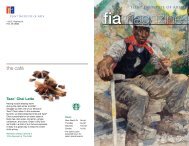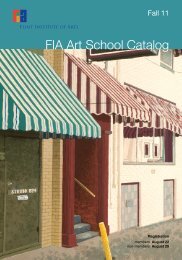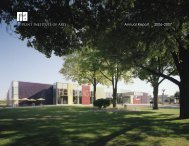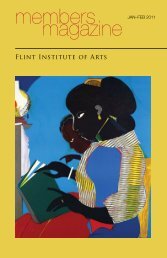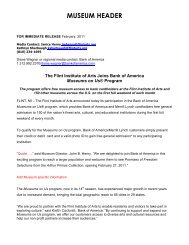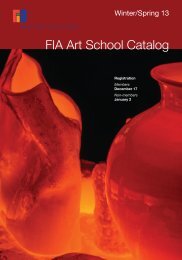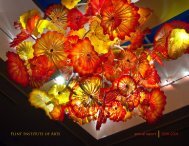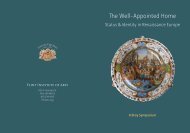members magazine - the Flint Institute of Arts
members magazine - the Flint Institute of Arts
members magazine - the Flint Institute of Arts
Create successful ePaper yourself
Turn your PDF publications into a flip-book with our unique Google optimized e-Paper software.
3 ExHIBITIONS<br />
Unbroken Ties<br />
Dialogues in Cuban Art<br />
through 12.7.10<br />
Hodge & Temporary Exhibition Galleries<br />
Sponsored by<br />
Community Foundation<br />
<strong>of</strong> Greater <strong>Flint</strong> through<br />
grants advised by:<br />
Mary Ann Tremaine<br />
Endowment Fund<br />
Peter D. and Nancy P.<br />
Kleinpell Family Fund<br />
The exhibition Unbroken Ties:<br />
Dialogues in Cuban Art, organized by<br />
<strong>the</strong> Museum <strong>of</strong> Art | Fort Lauderdale,<br />
Nova Sou<strong>the</strong>astern University, is culled<br />
from <strong>the</strong>ir collection <strong>of</strong> contemporary<br />
Cuban art assembled by curator Jorge<br />
Santis. The exhibition reveals <strong>the</strong><br />
existence <strong>of</strong> an acutely Cuban point<br />
<strong>of</strong> view, based on shared concerns<br />
and is illustrated by a series <strong>of</strong><br />
comparisons and contrasts between<br />
individual works <strong>of</strong> art stressing <strong>the</strong>ir<br />
direct or indirect <strong>the</strong>matic linkage.<br />
The selected works represent three<br />
distinct groups <strong>of</strong> Cuban-born<br />
artists: men and women who were<br />
born on <strong>the</strong> island but developed<br />
pr<strong>of</strong>essionally abroad, artists who<br />
reached artistic maturity and later<br />
immigrated to <strong>the</strong> United States, and<br />
a younger group <strong>of</strong> artists who not<br />
only studied in <strong>the</strong>ir homeland but<br />
still reside <strong>the</strong>re. The visual dialogues<br />
are established in 56 works <strong>of</strong> art by<br />
41 different artists. Unbroken Ties is<br />
Eduardo Muñoz Ordoqui<br />
Cuba, b. 1964<br />
Untitled (Banishment Series),<br />
ilfochrome print, 1996<br />
25.5 x 37.75 inches<br />
Organized by <strong>the</strong> Museum <strong>of</strong><br />
Art | Fort Lauderdale, Nova<br />
Sou<strong>the</strong>astern University<br />
a multimedia exhibition consisting <strong>of</strong><br />
paintings, sculptures, photographs,<br />
graphic works, videos and installations.<br />
The exhibition is comprised <strong>of</strong> both<br />
renowned artists and emerging artists<br />
including Jose Bedia, Abelardo Morrell,<br />
María Magdalena Campos-Pons,<br />
Tony Mendoza, Tomás Sánchez, Raúl<br />
Cordero, Kattia García Fayat and<br />
Miguel Florido.<br />
Structurally, <strong>the</strong> exhibition is divided<br />
into three sections, each concerning<br />
a different aspect <strong>of</strong> Cuban culture.<br />
The first consists <strong>of</strong> works that pertain<br />
to Cuba before and after Castro and<br />
<strong>the</strong> fight for survival. The second, <strong>the</strong><br />
treacherous journey to <strong>the</strong> United<br />
States and <strong>the</strong> risks Cuban immigrants<br />
take to get a “fresh start.” The last<br />
group examines what happens once<br />
<strong>the</strong> immigrants reach <strong>the</strong> United States<br />
and <strong>the</strong> new set <strong>of</strong> challenges and<br />
frustrations that await <strong>the</strong>m <strong>the</strong>re.<br />
ExHIBITIONS 4<br />
3-D: Focus on <strong>the</strong> Figure<br />
12.18.10 – 1.30.11<br />
Hodge & Temporary Exhibition Galleries<br />
Giovanni della Robbia<br />
Italian, 1469–1529<br />
Figure <strong>of</strong> an Angel<br />
tin-glazed ear<strong>the</strong>nware, n.d.<br />
26 x 9 x 9 inches<br />
Gift <strong>of</strong> Viola E. Bray, 2005.153<br />
William Zorach<br />
American, b. Lithuania,<br />
1887–1966<br />
Spirit <strong>of</strong> <strong>the</strong> Dance<br />
bronze, 1932<br />
76 x 31 x 48 inches<br />
Gift <strong>of</strong> Mr. and Mrs. Charles<br />
Stewart Mott, 1965.10<br />
The human form has provided<br />
sculptors with inspiration for thousands<br />
<strong>of</strong> years. The very first sculptures<br />
created were stylized representations<br />
<strong>of</strong> <strong>the</strong> human form. In Western Art, <strong>the</strong><br />
human form has evolved over several<br />
centuries from predominantly religious<br />
and mythological subject matter to<br />
works that come close to abstraction.<br />
Traditionally artists work in materials<br />
like metal, stone or clay; however,<br />
contemporary works incorporate a<br />
great variety <strong>of</strong> materials like silicone,<br />
textiles and even hair!<br />
This exhibition celebrates <strong>the</strong> rich<br />
history <strong>of</strong> depicting <strong>the</strong> human form in<br />
three dimensions with more than forty<br />
sculptures spanning over five centuries,<br />
and includes Renaissance and Baroque<br />
works by Giovanni della Robbia and<br />
Gerolamo Campagna, Antonio Canova<br />
to Modernist and contemporary works<br />
by Auguste Rodin, Pablo Picasso and<br />
Duane Hanson.



